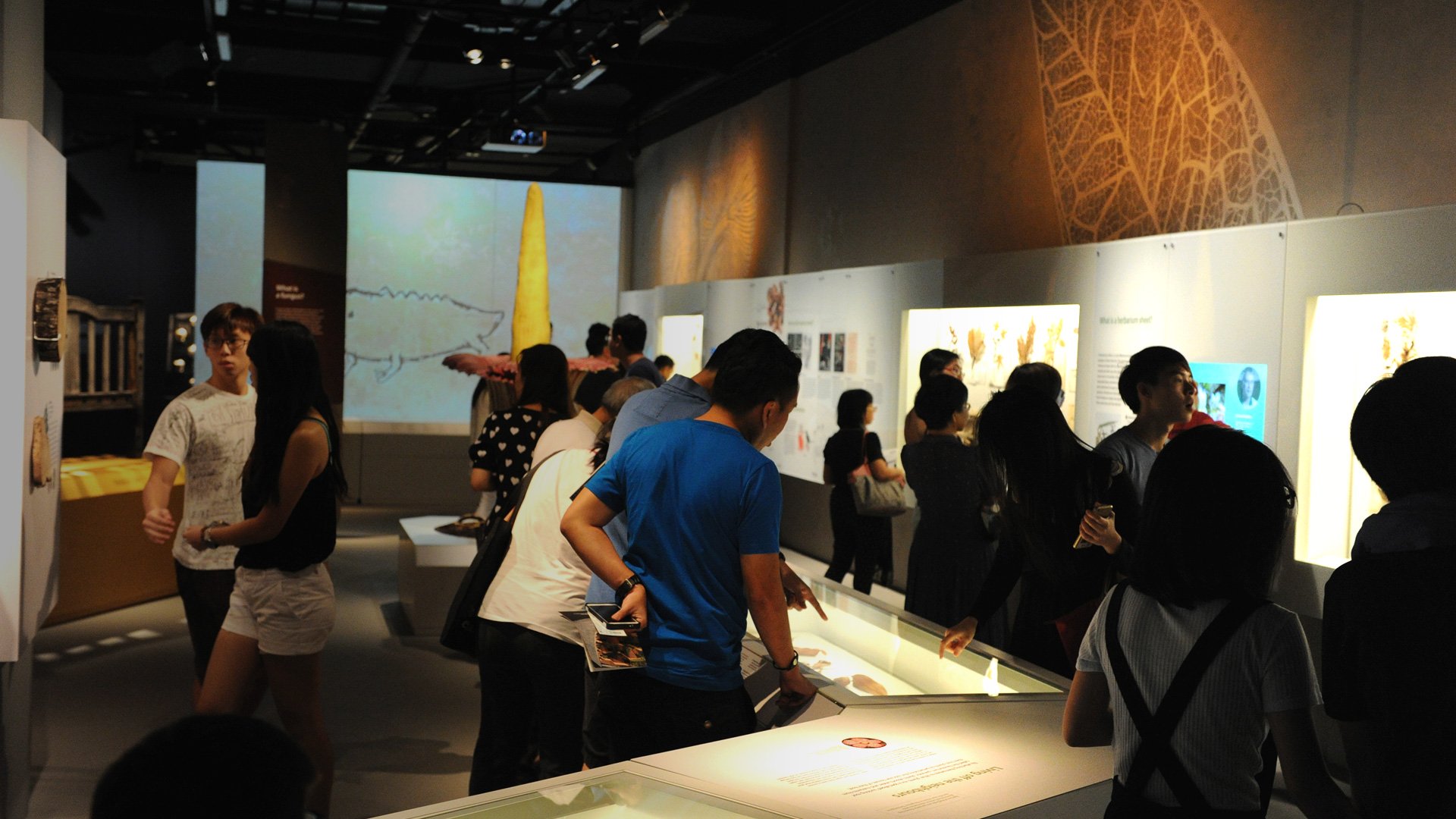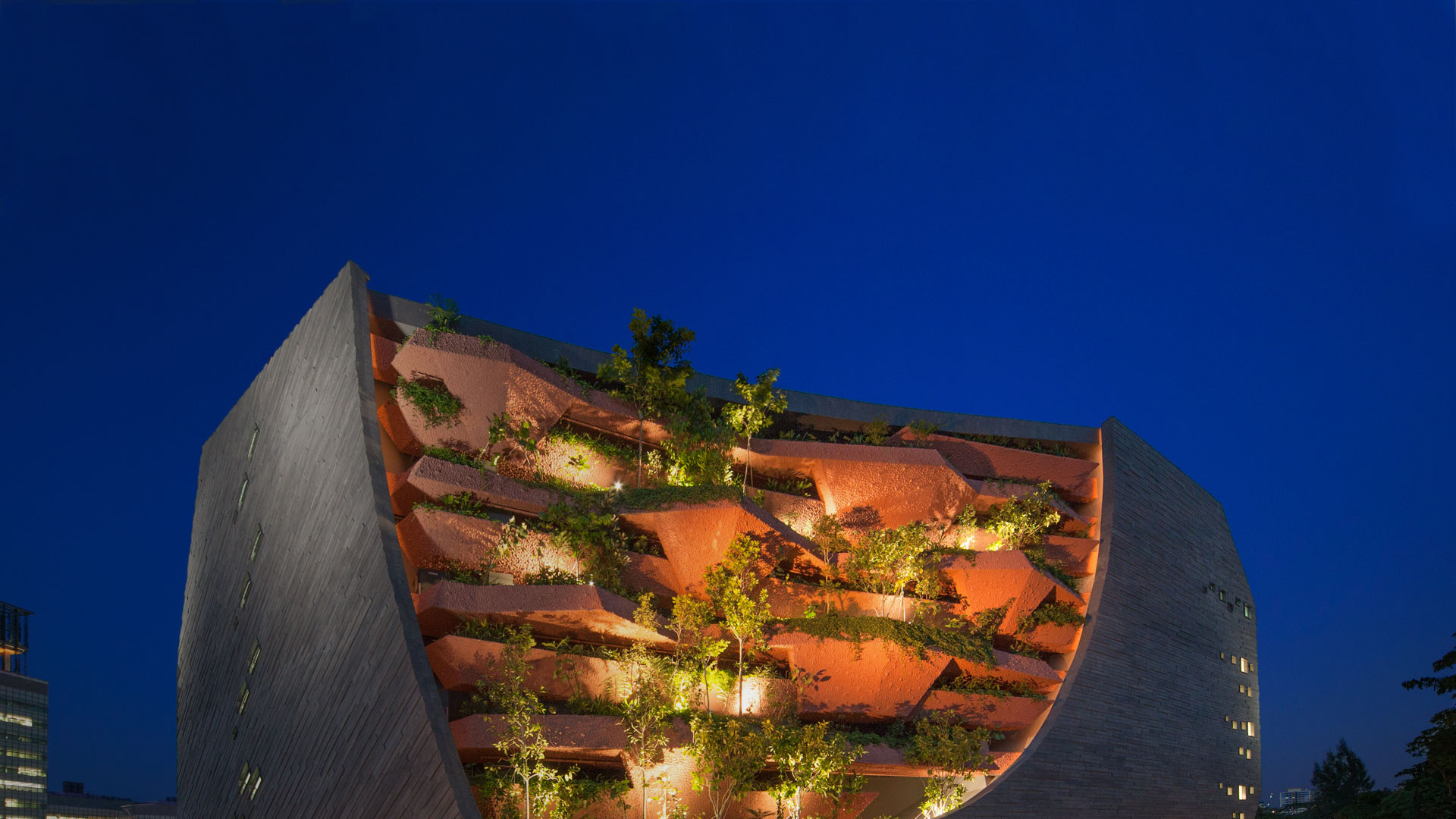Air Tenang

Air yang tenang jangan disangka tiada buaya / Water that is still may not be empty of crocodiles
Crocodylus porosus Schneider, 1801, is the largest of all living reptiles with females measuring an average of 3 metres in length, and males at 5 metres. The species has a large distribution range through northern Australia, Oceania, Southeast Asia and South Asia.
This is partly due to the species’ ability to venture out in the open sea and take advantage of currents. The Saltwater Crocodile lives in mangrove and brackish areas and will often bask on muddy and sandy banks during low tide.
When a female is ready to lay eggs, she will seek out water bodies unaffected by tidal movements to build a nest. This includes areas such as inland swamps and freshwater areas such as lakes, lagoons and reservoirs.
![]() The exhibition focused on the presence of the Saltwater Crocodile in Singapore, with an in-situ restoration of ‘Kaiser’, a preserved crocodile donated to the museum in 2017.
The exhibition focused on the presence of the Saltwater Crocodile in Singapore, with an in-situ restoration of ‘Kaiser’, a preserved crocodile donated to the museum in 2017.
CROCODILES IN SINGAPORE
Crocodiles have been known to inhabit Singapore since their earliest mention in the part-historical Hikayat Hang Tuah (c.1641 to 1739), a famous Malay work of literature. Upon a visit to Singapore, the Raja of Melaka’s crown fell into the water and when asking for it to be salvaged “no one came forward, for the Straits of Singapura was infested with man-eating crocodiles, and its water ran very deep”.
The earliest site-specific record is found in Hikayat Abdullah (1849), written by Abdullah bin Abdul Kadir, also known as Munshi Abdullah. Farquhar’s dog was snatched from the bank of the Rochore River c.1820 by a 5.5-metre-long crocodile. Farquhar ordered for the river to be barricaded. The crocodile was speared to death and hung from a jawi-jawi (fig) tree near Institution Bridge along the Bras Basah River.
As Singapore developed through urbanisation, so did the encounters between people and crocodiles. In the 200 years since Farquhar’s confrontation there have been over 380 reports in newspapers. On several occasions dog collars and bones were found inside culled crocodiles, and in 1886 the remains of a missing woman, a clam collector from Punggol, was discovered in a crocodile carcass (and later identified by her mother).

Photo credit: Tan Heok Hui, 2018
Example of a dog skull similar to those found inside culled crocodiles in the past
Canis lupus familiaris Linnaeus, 1758
Singapore
2000s

Photo credit: Tan Heok Hui, 2018
Japan Venus, an example of clams which may have been picked by the clam collector in 1886
Marcia japonica (Gmelin, 1791)
Singapore, Seletar Dam, mangroves
2017

GALLERY IMPRESSION: AIR TENANG, 2018
In 1852, the government offered rewards for the capture of crocodiles, although commercial use of the skins only began in the 1920s. Today, Singapore is known worldwide for its crocodile skin industry which supplies luxury goods firms. More locally, the by-products are used in Traditional Chinese Medicine; crocodile oil for skin ailments and the meat is believed to treat asthma and eczema.
Crocodile farms and reptile parks, such as Jurong Reptile and Crocodile Paradise, were also formerly hubs of entertainment, offering audiences tantalizingly-close contact with the captive animals and putting on crocodile wrestling performances. These could draw crowds of around 800 people.
Photograph from a private collection
Crocodile Farm
Singapore, 1970s

Photograph courtesy of Syed bin Taha
Jurong Crocodile and Reptile Paradise
Daily Performance
Singapore 1989
An old skull in the Museum’s collection was recently determined to be one of the largest in the world. Currently, the largest saltwater crocodiles recorded are ‘Corroboree’, from Point Stuart in Northern Territory, Australia, measuring 6.7 metres, and ‘Lolong’ from Bunawan, Agusan del Sur, Philippines measuring 6.17 metres. Using a formula of specific measurements, it is possible to determine the total length of a crocodile from its skull, meaning it would have belonged to a crocodile measuring 6.7 metres. This specimen was later named ‘Edgar’ after Mr G. Edgar who presented the skull to the museum in 1887.
More about the discovery can be found in the subsequent paper published in 2018 by Fukuda et
al: https://lkcnhm.nus.edu.sg/wp-content/uploads/2020/05/66rbz810-813.pdf

Photo Credit: Tan Heok Hui, Dzaki Safaruan, Jeanice Aw, 2020
‘Edgar’, Saltwater Crocodile
Crocodylus porosus Schneider, 1801
Java, 1887

GALLERY IMPRESSION: AIR TENANG, 2018
Kaiser is a Saltwater Crocodile, Crocodylus porosus Schneider, 1801, that was donated to the Museum in May 2017 by the Singapore Zoo. It is estimated that he was 40 years old when he died in April 2007. He had been given to the zoo in 1991, suspected to have been found in the wild.
Upon death, Kaiser’s skin underwent taxidermy treatment to preserve the body and was stuffed with tightly packed textiles, which made him ‘weigh’ around one tonne!
His actual weight at death was recorded as 515 kg.

Photo credit: Kelvin Lim Kok Peng
Kaiser at the Singapore Zoo in 2005
Taxidermy was often used to preserve hunting ‘trophies’ and many of the crocodiles shot in Singapore in the 1800s were displayed in colonial homes. Some were even sent back to England.
However, the old process of taxidermy incorporated very different materials than those used today.
In the past, arsenic was popular as it preserved the skin from decay and prevented insects, such as moths and beetles, from eating away at the skin; but due to its extreme toxicity it is no longer used.
Once the insides were removed, newspaper or straw was typically used to form a fake body inside the skin to give shape. Such materials were readily available and could be moulded easily. Nowadays, with modern materials such as silicone and foam, the body shape is often created from a mould that is carved to mimic anatomical tones. The skin is then sewn over the synthetic body.
Joseph Tan, one of Singapore’s two practicing taxidermists, came to the museum to work with our conservator to replace the stuffing with foam that is inert, non-acidic, durable, light-weight and easily-shaped to fill cavities, such as the legs. Kaiser is now much lighter and can be moved with much less people.

Photo credit: Iffah Iesa, 2018
Joseph Tan removing more of the multicoloured textiles from inside the body
In the 10 years since Kaiser had been preserved, unstable environmental conditions had caused slow degradation to the skin; some areas of skin were flaking, the mouth was cracked, teeth were missing and the glass eyes that had been fitted were not realistic when compared to a living example of this species. They were therefore replaced with high-quality glass eyes designed specifically for crocodile specimens.

Photo credit: Kate Pocklington, 2017
Before restoration: Kaiser’s glass eye upon preservation in 2007. Flaking skin can also be seen around the eyelid.

Photo credit: Iffah Iesa, 2018
During restoration: The replacement glass eye with restoration work to the eyelid for a more natural appearance.

Photo credit: Kate Pocklington, 2018
After restoration: Kaiser’s eye is more representative of living examples
The final part of restoration was carried out on the cracking skin and deterioration to the mouth. The skin was dull and not representative of a living example; this was treated by consolidating the flaking skin and re-touching the colour with conservation-grade paints.
Missing teeth were sculpted, inserted, and colour-matched. The mouth was stabilised for long-term preservation and repainted.

Photo credit: Kate Pocklington, 2018
During restoration: Cracking skin, missing teeth and colour loss were all symptomatic of fluctuating environmental conditions, theft and age

Photo credit: Kate Pocklington 2020
Kaiser after restoration
Kaiser is now on display at the Reptiles Zone in the Biodiversity Gallery of Lee Kong Chian Natural History Museum

Photo credit: Kate Pocklington, 2020
Kaiser at the Reptiles Zone, LKCNHM




